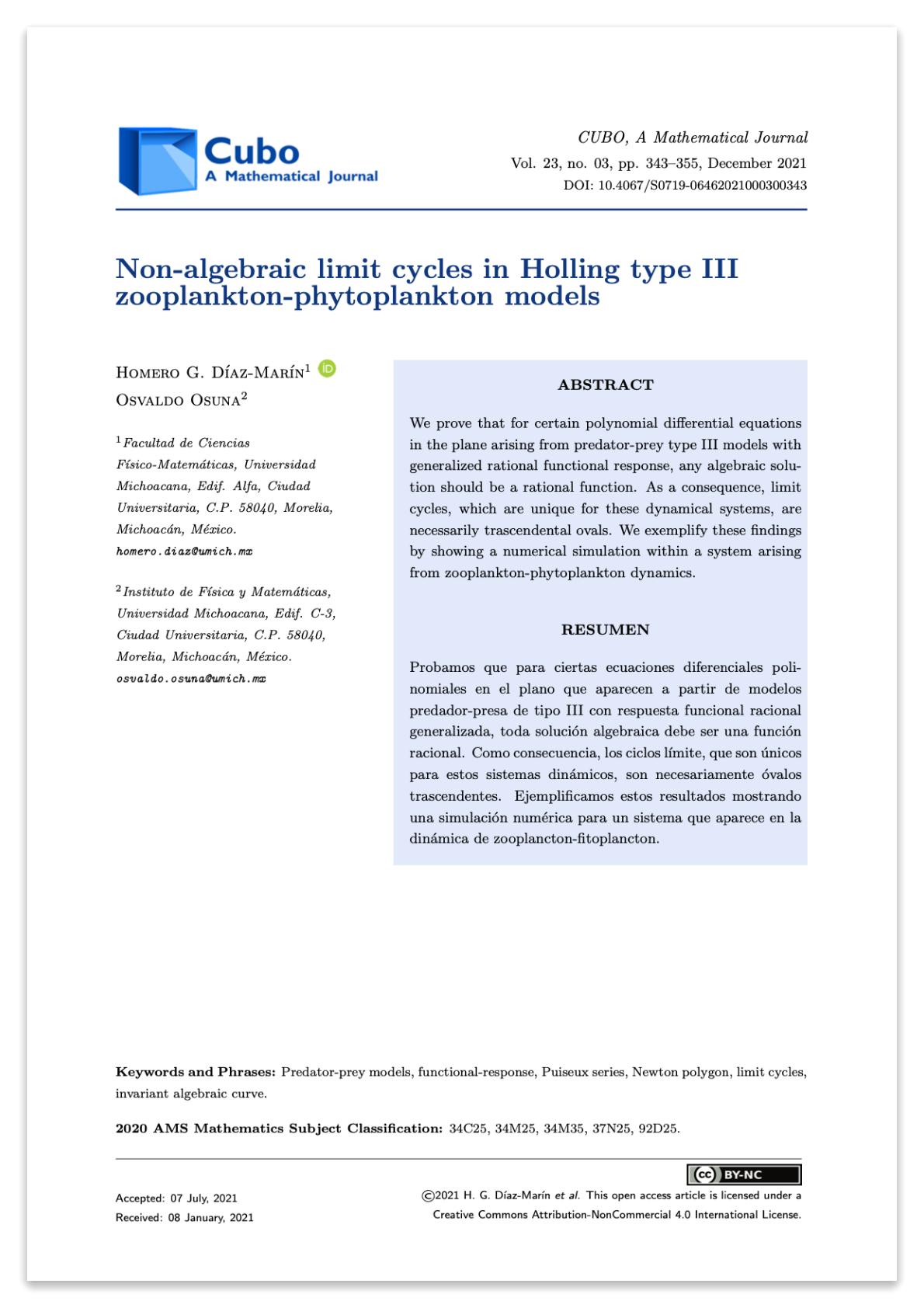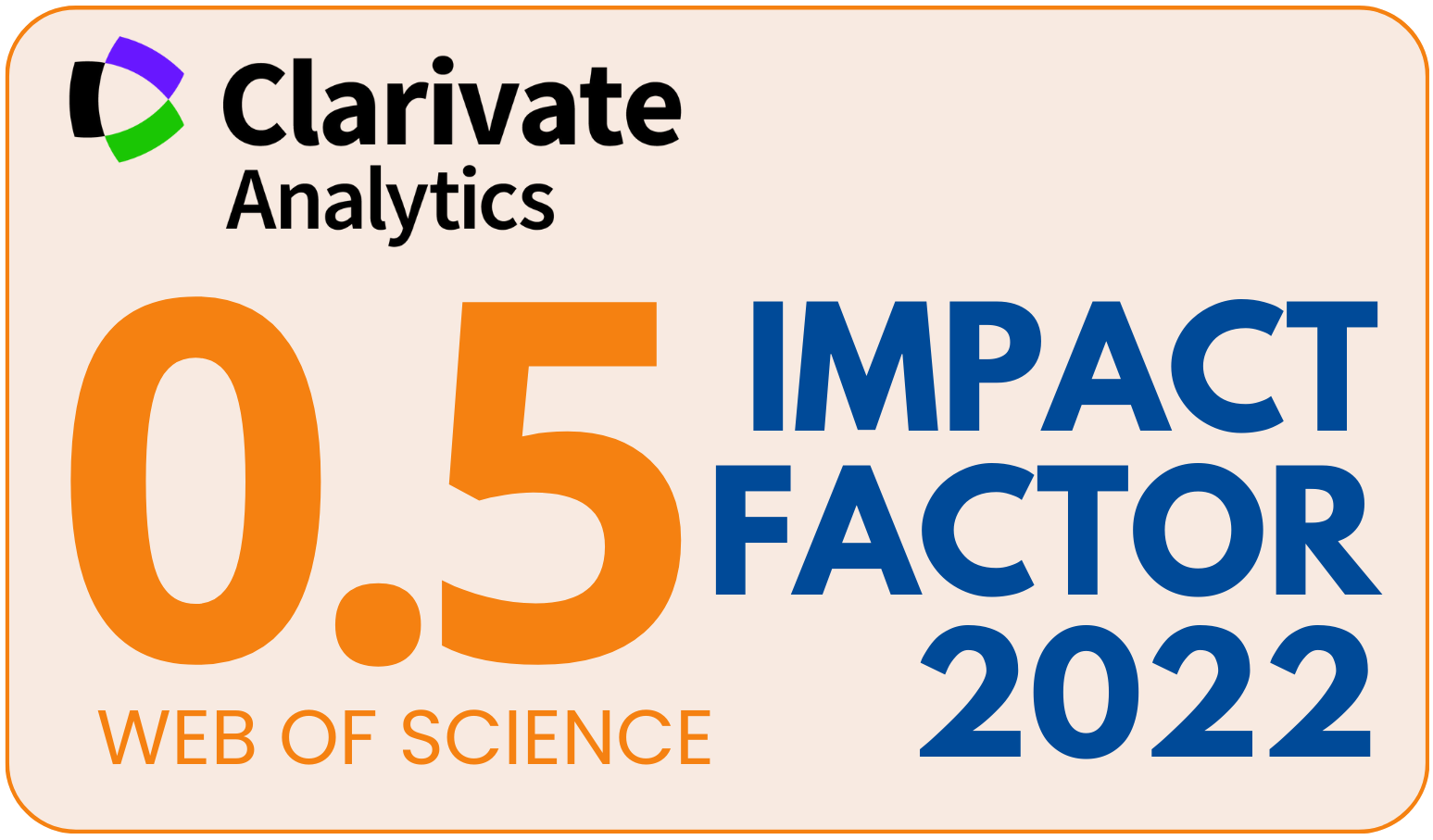Non-algebraic limit cycles in Holling type III zooplankton-phytoplankton models
-
Homero G. Díaz-Marín
 homero.diaz@umich.mx
homero.diaz@umich.mx
-
Osvaldo Osuna
 osvaldo.osuna@umich.mx
osvaldo.osuna@umich.mx
Downloads
DOI:
https://doi.org/10.4067/S0719-06462021000300343Abstract
We prove that for certain polynomial differential equations in the plane arising from predator-prey type III models with generalized rational functional response, any algebraic solution should be a rational function. As a consequence, limit cycles, which are unique for these dynamical systems, are necessarily trascendental ovals. We exemplify these findings by showing a numerical simulation within a system arising from zooplankton-phytoplankton dynamics.
Keywords
D. Barrios-O‘Neill, J. T. A. Dick, M. C. Emmerson, A. Ricciardi and H. J. MacIsaac, “Predator-free space, functional responses and biological invasions”, Functional Ecology, vol. 29, no. 3, pp. 377–384, 2015.
J. Cano, “An extension of the Newton-Puiseux polygon construction to give solutions of Pfaffian forms”, Ann. Inst. Fourier (Grenoble), vol. 43, no. 1, pp. 125–142, 1993.
M. V. Demina, “Novel algebraic aspects of Liouvillian integrability for two-dimensional polynomial dynamical systems”. Phys. Lett. A, vol. 382, no. 20, pp. 353–1360, 2018.
M. V. Demina, “Invariant algebraic curves for liénard dynamical systems revisited”, Appl. Math. Lett., vol. 84, pp. 42–48, 2018.
A. Ferragut and A. Gasull. “Non-algebraic oscillations for predator-prey models”, Publ. Mat., vol. 58, suppl., pp. 195–207, 2014.
J. Giné and M. Grau, “Coexistence of algebraic and non-algebraic limit cycles, explicitly given, using Riccati equations”, Nonlinearity, vol. 19, no. 8, pp. 1939–1950, 2006.
J. Giné and J. Llibre, “Strongly formal Weierstrass non-integrability for polynomial differential systems in C2”, Electron. J. Qual. Theory Differ. Equ., no. 1, pp. 1–16, 2020.
J. Giné and J. Llibre, “Formal Weierstrass nonintegrability criterion for some classes of polynomial differential systems in C2”, Internat. J. Bifur. Chaos Appl. Sci. Engrg., vol. 30, no. 4, 7 pages, 2020.
M. Hayashi, “On polynomial Li Ìenard systems which have invariant algebraic curves”, Funkcial. Ekvac., vol. 39, no. 3, pp. 403–408, 1996.
E. Hille, Ordinary Differential Equations in the Complex Domain, Dover Publications, Inc., Mineola, NY, 1976.
E. L. Ince, Ordinary Differential Equations, Dover Publications, New York, 1944.
K. Odani, “The limit cycle of the van der Pol equation is not algebraic”, J. Differential Equations, vol. 115, no. 1, pp. 146–152, 1995.
L. A. Real, “The kinetics of functional response”, The American Naturalist, vol. 111, no. 978, pp. 289–300, 1977.
B. Rosenbaum and B. C. Rall, “Fitting functional responses: Direct parameter estimation by simulating differential equations”, Methods in Ecology and Evolution, vol. 9, no. 10, pp. 2076–2090, 2018.
V. A. Ryabchenko, M. J. R. Fasham, B. A. Kagan and E. E. Popova, “What causes short-term oscillations in ecosystem models of the ocean mixed layer?”, Journal of Marine Systems, vol. 13, no. 1, pp. 33–50, 1997.
J. Sugie, “Uniqueness of limit cycles in a predator-prey system with Holling-type functional response”, Quart. Appl. Math., vol. 58, no. 3, pp. 577–590, 2000.
J. Sugie, R. Kohno, and R. Miyazaki, “On a predator-prey system of Holling type”, Proc. Amer. Math. Soc., vol. 125, no. 7, pp. 2041–2050, 1997.
R. K. Upadhyay and S. R. K. Iyengar, Introduction to Mathematical Modeling and Chaotic Dynamics, CRC Press, 2013.














